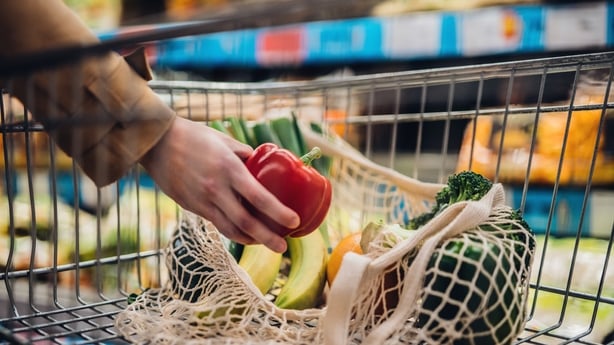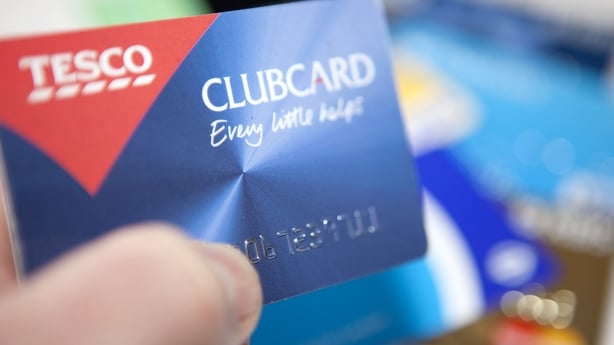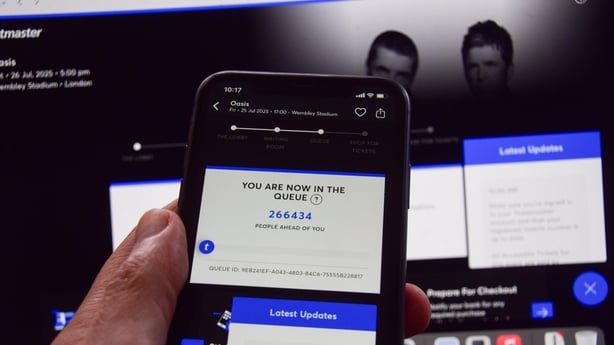When Ireland took to the polls in November to elect the next Dáil it was clear that money was on the mind.
Almost one in five voters said the cost of living was the single most important issue for them, with a further 9% citing economic stability as their big issue.
This reflected what the statistics for 2024 show us – the rate of inflation may have dropped this year, but prices are still rising.
Irish inflation fell to a three year low at the close of 2024, but many consumers are still waiting to feel the effects.
At the start of the year prices were up around 4% on the start of 2023.
That's based on the Central Statistics Office's official measure of inflation - the Consumer Price Index (CPI).
This tracks the overall change in the price of goods and services that people typically buy over time, and includes the cost of mortgage interest.
By the end of the year, the index had dropped to around 1%.
While this is good news, prices are still rising and 2024 was a tough year financially for many.
Why are consumers still struggling?
Irish households are still reeling from 2022 when inflation peaked at over 9%.
This brought with it the worst cost of living crisis the country had seen in almost 40 years.
Research carried out by EY back in June, showed that Irish consumers were not alone with their concerns.
Over 60% of Irish households and 55% of global households said they were extremely concerned about the cost of living.
This outweighed other concerns such as geopolitical conflict, climate change and personal finances.
In this study, the cost of essentials like energy, groceries and healthcare emerged as the biggest concerns.

How is the rest of Europe coping?
The EU measures inflation slightly differently to Ireland's CPI.
It uses the Harmonised Index of Consumer Prices (HICP), which excludes mortgage interest.
Its reading for Ireland fell to 0.5% in November, which is lower than the CPI reading of 1% which includes mortgage interest.
The latest Eurostat figures show that the rate of inflation across the Euro area, as measured by the HICP increased to 2.2% in November, up from 2% in October.
This rise was driven by the price of services, which is mostly driven in turn by wages.
The rate of inflation in the wider European Union was 2.5%. A year earlier, the rate was 3.1%.
Ireland had the lowest level of inflation in November among EU members, with prices up just 0.5% compared to a year earlier.
Lithuania and Luxembourg had the next lowest annual rates at 1.1%.
The highest annual rates were recorded in Romania at 5.4%, Belgium at 4.8% and Croatia at 4%.
What's driving Irish inflation down?
Falling inflation has largely been driven by a continued drop in energy prices.
Wholesale electricity prices are now over 60% lower than the peak in August 2022.
As a result, most electricity and gas companies are offering much steeper discounts on deals for new customers than they were two years ago.
Competition between those companies in the switcher market hotted up again this year and a number of the big players announced price reductions.
While energy bills and the prices at the petrol pumps may have moderated, that's not the case at the supermarket.
Grocery prices are still rising well ahead of overall inflation and many people will have had a shock when getting to the till at some point this year.
The annual rate at which grocery prices increased edged up towards the end of the year to 3.6%.
While still high, this was down from almost 17% at the peak of the cost of living crisis.
But that didn't make the expense of the Christmas shop any easier.
Figures from Kantar show that the cost of an average Christmas dinner for four increased by 2% on last year, mainly driven by the price of turkey and Christmas vegetables.
The cost of brussels sprouts and mince pies jumped over 10% when compared to Christmas 2023.

Are consumers getting good deals?
Consumers made it their mission to find the best value this year, with many availing of supermarket vouchers and reward schemes.
However, back in June, Tesco Ireland was found to be in breach of consumer protection law in how they displayed the price of products offered at a promotional price to its Clubcard holders.
The findings came from an investigation carried out by the Competition and Consumer Protection Commission (CCPC), which is responsible for enforcing and promoting compliance with consumer protection law here.
It found that Tesco broke the law by failing to include unit pricing on Tesco Clubcard promotional shelf-edge labels.
The CCPC said that shoppers have to quickly evaluate a wide range of factors when deciding what products offer the best value for their money.
Supermarkets are legally required to show unit pricing - to make that process easier for consumers.
The retailer was ordered to pay the legal costs of the CCPC and a donation of €1,000 to the Little Flower Penny Dinners charity.

An Oasis from inflation?
The big cost of living pressure around this time of year will be Christmas presents.
Many people across Ireland and the UK will be opening tickets for the 19 sold out Oasis concerts across the two islands.
But a term new to most, 'dynamic pricing', angered many fans when tickets went on sale.
Initially advertised as starting from €86.50 when avid Oasis fans flocked to Ticketmaster for the reunion tour, some people ended up paying more than €400 for tickets.
Data from AIB found people spent on average €347 on Oasis tickets.
The CCPC launched an investigation into the pricing after receiving more than 100 complaints from members of the public.
The band said it was unaware dynamic pricing would be used for the concerts and the prices reflect an unprecedented level of demand.
That said, Oasis won't be using dynamic pricing when selling tickets for the US leg of the tour.
Liam Gallagher meanwhile was far from apologetic towards fans on social media platform X, stopping just short of telling them to stop crying their hearts out.

Did the Budget help ease cost of living pressures?
Cost pressures remained in focus in the months leading up to the budget.
In September, Paschal Donohoe, then Minister for Public Expenditure and Reform said the size of the cost of living package would reflect the fall in inflation.
"Even though inflation is coming down, prices are still going up," Mr Donohoe said at the time.
The Government sought to walk a tightrope between cutting the level of one off payments that had been seen in previous years and not leaving vulnerable households unsupported.
Fast forward to October, and a €2.2 billion cost of living package was announced.
This included two €125 electricity credits and two double child benefit payments.
Minister Donohoe acknowledged that many people were still worrying about their finances, despite the fall in inflation.
What makes a crisis?
However, some this year questioned whether there was ever a cost of living crisis.
The CEO of IBEC Danny McCoy said the increased cost of living can't be considered a crisis for the majority of people who are getting pay rises.
Mr McCoy argued inflation isn't a crisis for most, and said calling it that does a disservice to those who are genuinely struggling.
"When you stand back from it, the average disposable income in Ireland has actually been growing in line ahead of the inflation - particularly the last decade, but even in the last couple of years - because we have actually been compensating for those elevated costs," he said.
He's right that wages are rising, with many companies increasing salaries throughout the year.
Figures from the CSO show that wages, as measured by average weekly earnings, rose at an annual rate of 5.6% in the second quarter of this year - much faster than the rate of inflation.
Throughout the year, many unions and workers fought for pay increases in their sector - including bank staff, public and private sector workers, retained firefighters, and many more.
A number of deals were secured including a public sector pay deal, and a deal for pilots at Aer Lingus following a long-running dispute.
For those on the minimum wage, changes announced in the budget will see a hike of 80 cents per hour to €13.50 per hour from the start of 2025.
But despite this, many workers are continuing to struggle, and will be holding out for that pay rise in 2025.







